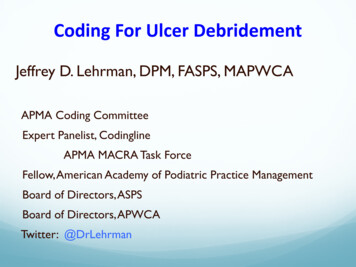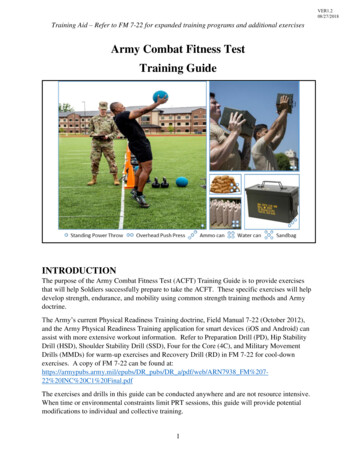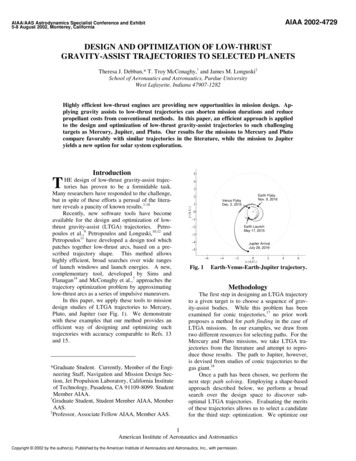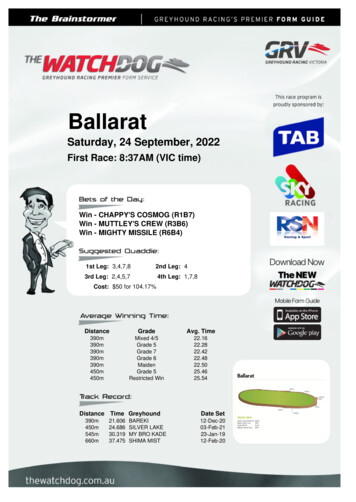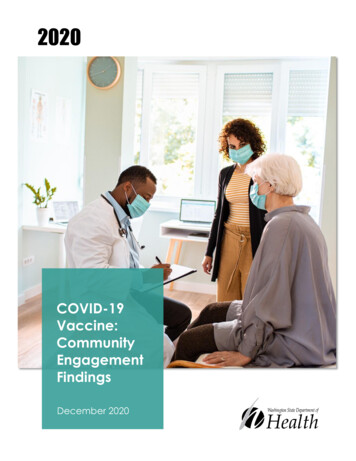
Transcription
ember 2020
To request this document in another format, call 1-800-525-0127. Deaf or hard of hearingcustomers, please call 711 (Washington Relay) or email civil.rights@doh.wa.gov.Publication Number820-116For more information or additional copies of this report:Center for Public AffairsCommunity Relations and Equity101 Israel Road SETumwater, WA 98501Covid.Vaccine@doh.wa.govWe want to thank all of the community members, partners, and leaders whoprovided their time, feedback, and perspective during this process. Your inputhas been immensely beneficial to our COVID-19 vaccine planning efforts.Thank you,The COVID-19 Vaccine Planning Team
ContentsIntroduction . 1Focused Engagement Approach . 1Focused Engagement Analysis . 3Broad Engagement Approach . 3COVID-19 and Health Equity Considerations . 4Disparities in Cases, Hospitalizations, and Deaths . 4Confirmed Case Rates . 5Hospitalization Rates among Confirmed Cases . 6Death Rates among Confirmed Cases. 6Causes of Health Inequities in COVID-19 Health Outcomes . 6Access Barriers . 7Employment Conditions. 7Housing . 7Other Unintended Consequences. 8Equity as a Cross-Cutting Factor . 8Understanding COVID-19 Risks . 91. Older Adults are at risk due to their work, where they live, family gatherings, orcultural shared spaces. 92. Those who face barriers to health care or quality health care are at risk . 93. People with underlying health conditions are at risk . 104. People who live in congregate living situations or in multi-generational homes are atgreater risk . 105. People who are exposed to others and/or the general public at work and/or in worksettings where proper protocols are not taken are at greater risk . 11Disproportionate Impacts: Many interconnected layers . 131. COVID-19 affects many individuals within families and between families . 132. Impacts reach people in their homes . 133. Impacts happen in the workplace . 142 WASHINGTON STATE DEPARTMENT OF HEALTHCOVID-19 VACCINE: COMMUNITY ENGAGEMENT FINDINGS
4. The social safety net is necessary to catch people but it, too, is damaged by COVID-19145. The “wellness” of low-income people and POC is already fragile and the fragility isfurther exacerbated by COVID-19 . 156. COVID-19 requires health resources that are not easily accessible to manycommunities especially when the demand increases exponentially . 16COVID-19 Impacts . 161. Difficult to follow COVID-19 preventative behaviors without adequate support andenforcement . 16Misinformation and Distrust . 171. Vaccine hesitancy due to historical trauma and mistrust of government agencies andhealth care entities . 172. Community trust is impacted by misinformation related to how the COVID-19 vaccineis being managed/manipulated by the government . 173. Many people rely on digital media for information whether or not the digitalinformation sources are accurate or factual . 184. There are a lot of conspiracy theories and misinformation regarding the COVID 19vaccine and any developments of a vaccine. 185. Those who are unable to access timely, accurate information or only seemisinformation and disinformation are at risk. . 19Fears about the vaccine: safety, development, efficacy, logistics . 191. There are many different concerns and fears about the COVID-19 vaccine . 202. Most cited fears clustered around safety and efficacy . 203. Concerns about the process of development, the quality/rigor of the science, and thechallenges of conquering a mutating virus formed the foundation of many fears. . 214. Fears are exacerbated by a perceived lack of transparency, lingering questions andsilencing of scientists. . 21Vaccine Prioritization . 221. There is support for prioritizing high-risk workers in health care settings, but we alsoneed to intentionally define a high-risk role or environment. . 222. Prioritization for key groups including farmworkers, elders, people with disabilities,and communities of color should be stronger. 22
3. Many essential services sectors feel left out and under-prioritized. 234. There is overall support for the National Academies of Medicine Equitable COVID-19Allocation Frameworks’ principles, criteria, and equity considerations. . 23Motivation to get the vaccine . 241. Vaccination is an essential part to assist in returning to a resemblance of normal. . 242. The social emotional and mental health aspects of a vaccine are high motivations forvaccine acceptance. . 24Communications, Engagement and Outreach Activities . 251. Community engagement needs to start early and be done with trusted members in thecommunity. . 252. People want culturally and linguistically appropriate information. . 253. Communities trust people and organizations that look like them and have a reputationof community care. . 264. Communities also rely on public leaders, scientists and institutions when they speakdirectly, clearly, and apolitically. . 265. Consider access needs and formats for all COVID-19 communications. . 266. Ensure all public health, healthcare, and vaccine providers have the samecommunications resources. . 277. Communication efforts should focus on transparency and building trust as a centralgoal. . 27Equitable Distribution . 281. Need to proactively address common health care access barriers experienced regularlyby vulnerable communities; same barriers will impact vaccine access. . 282. Two dose series and refrigeration requirements may create challenges for servingsome communities. . 283. Set up vaccine clinics in places that are safe, familiar, and accessible. . 29Survey Findings: Public Feedback Opportunity. How Should Washington State Prioritize TheCOVID-19 Vaccine? . 30Intersectionality . 504 WASHINGTON STATE DEPARTMENT OF HEALTHCOVID-19 VACCINE: COMMUNITY ENGAGEMENT FINDINGS
IntroductionOver the course of October 2020, the Washington State Department of Health led acomprehensive community engagement effort to get feedback on how people are feeling aboutthe COVID-19 vaccine and perspectives for how COVID-19 vaccine should be prioritized andallocated in Washington state. This approach included both focused and broad engagementefforts. Focused efforts were more qualitative in nature and included a mixed methodsapproach. We did 90 total key informant interviews, group interviews, communityconversations, and focus groups with 568 total individuals representing a variety ofcommunities and perspectives. We were intentional in centering the experiencing ofcommunities most disproportionately impacted by COVID-19 and bringing groups together overshared experience rather than geography. The broad engagement approach provided an optionfor greater public feedback using a web-based survey. We collected and analyzed results basedoff occupational and other risk factors. The survey was available in multiple languages and wereceived 18,023 participants.Focused Engagement ApproachTo hear from communities most impacted by COVID-19 about the allocation and prioritizationframework, we used a mixed methods approach and conducted 90 separate interviews, groupinterviews, focus groups, and community conversations. These were conducted primarily byphone and video chat with 568 individuals across the state over a three-week period in October2020.The Department of Health’s internal COVID-19 Community Engagement Task Force led theseefforts. We also partnered with several of the existing Emergency Language and CommunityOutreach Services contractors and other partners to carry out additional culturally appropriatecommunity engagement efforts within their own communities. The information gatheredthrough these activities was also supplemented by advocacy letters from disproportionatelyimpacted businesses and other sectors, as well as by qualitative open-ended responses tosurvey questions.We engaged community members, partners, and representatives and asked participants to selfidentify the communities they belong to and/or represent. Most often, people self-identifiedwith more than one community. Over the course of all focused engagement efforts, weidentified representation from the following communities, groups, and sectors (Table 1).Participants identified as being connected with 28 counties or said they were connectedstatewide (Table 2). Being connected to a county includes the county that a participant lives inas well as the county or counties a participant works in. We did not focus our engagementWASHINGTON STATE DEPARTMENT OF HEALTHCOVID-19: COMMUNITY ENGAGEMENT FINDINGS 1
efforts on geographic communities, however, we do have the ability identify any geographicspecific feedback.Table 1: Community engagement group representationDisproportionatelyImpacted Communities1Essential Sectors, ServicesSectors, and IndustriesHealth Care andPublic Health PartnersOther High Priority Communities,Groups, and SectorsBlack/African AmericancommunityEssential and front-line workersLocal Health JurisdictionsChildren with special health care needsAgricultural sectorMigrant workersFarmworkersSeafood industryCommunity health clinicsYouthCommunity Health Workersand promotorasYouth in foster careParentsBusiness communityBehavioral health andsubstance use disorderservicesPublic transportationCommunity blood centersHospitality industryRural medical servicesPublic utilitiesPharmacyLatinx communityParks and recreationImmigrant and refugeecommunitiesTechnology sectorPost-acute and Long-TermCareAsian/Asian AmericancommunityNative AmericanNative Hawaiian and otherPacific Islanders communityMarshallese, Micronesian,and COFA (Compact ofFree Association)communitiesAsian diasporaFood bank servicesVeterinary careCollege and university studentsEarly learning and early childhoodLGBTQ communityRural communitiesBorder communitiesSub-urban communitiesFaith-based communitiesVeteransWomenAfrican diasporaLatin American diasporaFormer Soviet Union (FSU)diasporaUndocumented communitiesPeople with underlying healthconditionsOlder adultsPregnant peopleIndividuals with disabilitiesPeople experiencinghomelessnessPeople who are incarceratedLow-income communitiesUninsured communities1 Communitiesthat have experienced the greatest COVID-19 inequities related to cases, hospitalizations, deaths, and risk of severe illness. Participants self-identifiedas being in these groups and were often in more than one group.2 WASHINGTON STATE DEPARTMENT OF HEALTHCOVID-19 VACCINE: COMMUNITY ENGAGEMENT FINDINGS
Table 2: Counties of participantsAll (statewide)FerryKitsapPend kiakumAsotin*GarfieldKlickitat*San Juan*Walla ays *DouglasKing*Pacific*Stevens*Focused engagementeffortsFocused Engagement AnalysisFor all activities, either a designated note taker or the facilitator took notes. As needed, allengagement activities were facilitated in-language or with the assistance of an interpreter orCommunication Action Real-time Transcription (CART) services. We redacted all participantnames, saved all transcripts as text documents, and then uploaded into Dedoose (version8.3.35). A contractor analyzed qualitative data using thematic analysis. The codebook wasdeveloped iteratively and derived from assessment goals, data, and the prioritizationframework. Each transcript was coded individually, and the codebook was adapted asnecessary. Each code report was summarized into a table of theme domains and subdomainswith associated quotes.Broad Engagement ApproachWe also collected feedback from the broader public through a web-based survey. This surveywas provided in the following languages (see Table 3) and disseminated through existingpartner channels, Department of Health (DOH) listservs, the DOH website, and social mediaaccounts. We selected these languages because they are common in Washington state and wehave had success reaching people who speak them through other web-based communicationsduring the pandemic.Table 3: Survey respondents by languageLanguageNumber ofRespondentsEnglishSpanishVietnameseChinese (simplified)Chinese 029122WASHINGTON STATE DEPARTMENT OF HEALTHCOVID-19: COMMUNITY ENGAGEMENT FINDINGS 3
The survey was split into three parts: 1. How are you feeling about COVID-19?; 2. How shouldwe decide who gets the vaccine first?; and 3. Tell us about yourself (optional). In addition toanalyzing the overall survey results, we also filtered and analyzed the results by therespondent’s area of work and whether they identified as someone at increased risk for COVID19 because of their race/ethnicity, disability status, or overall health and age.Our analysis included all in-language surveys that had at least 10 respondents. These surveyresults supplement what we learned through the qualitative, focused engagement efforts withthese respective communities. We also collected information about the specific countyrespondents reside in.COVID-19 and Health Equity ConsiderationsThe COVID-19 pandemic has shed light on existing health inequities, amplified them, andrevealed their root causes. The inequities in cases, hospitalizations, and deaths, among othertelling metrics, are the result of broader societal and structural factors like racism and otherforms of oppression. These structural factors result in differential access to resources, services,and opportunities, including access to health care.Inequities can be exacerbated or alleviated by intersecting identities. For example, recentresearch has shown that nurses of color are more likely to die from COVID-19 than their whitecounterparts. While occupation data is not available for all COVID-19 deaths, available datashowed that registered nurses accounted for 30 percent of COVID-related deaths among healthcare workers nationally. Approximately 24 percent of registered nurses in the United States areindividuals of color, but people of color accounted for 58 percent of deaths from COVID-19among registered nurses. By comparison, 75 percent of registered nurses are white andaccounted for 40 percent of deaths. Another study showed more broadly that health careproviders with COVID-19 who died tended to be older, male, Asian, Black, and have anunderlying medical condition when compared with health care providers who did not die.Disparities in Cases, Hospitalizations, and DeathsThere are stark differences in COVID-19 cases, hospitalizations, and deaths for certaincommunities. The disparities we see in exposure and illness are also impacting many of thesame historically marginalized groups that experience other health inequities. This is true at thestate level and the national level. There are other communities that experience inequitiesrelated to COVID-19 that are not well captured in our data systems, for example people withdisabilities. Additionally, a lack of disaggregation for large groups, for example byrace/ethnicity, can mask differences in outcomes at a sub-population level.4 WASHINGTON STATE DEPARTMENT OF HEALTHCOVID-19 VACCINE: COMMUNITY ENGAGEMENT FINDINGS
The Department of Health’s COVID-19 morbidity and mortality by race, ethnicity and spokenlanguage in Washington state report, COVID-19 Confirmed Cases by Industry Sector and currentdata dashboard further details the disparities that do appear within currently available data.The Department of Health acknowledges these limitations and is actively working to promotedata equity and address the systemic and technical challenges to more representative datacollection systems. The following data are provided by the Washington State Department ofHealth.Confirmed Case RatesIn terms of age-adjusted confirmed case rates:Native Hawaiian and Other Pacific Islander (NHOPI) and Hispanic populations have thehighest rates, while white and Asian people have the lowest. NHOPI and Hispanic populations have approximately six times higher rates than Asianand white populations. Black populations have approximately three times higher rates Asian and whitepopulations. American Indian/Alaska Native people account for 2 percent of COVID-19 cases but only1 percent of the total population. Table 4. Percentages of confirmed COVID-19 cases hospitalized by primary languagespokenLanguageCasesHospitalizationsPercent language specific ussian53311020.6%Chinese ther90011612.9%Employment data also shows disparities in COVID-19 cases among certain industries. In a reportpublished on November 10, 2020, lab-confirmed cases of COVID-19 among residents reportedthrough 11:59 PM on September 13, 2020 showed:WASHINGTON STATE DEPARTMENT OF HEALTHCOVID-19: COMMUNITY ENGAGEMENT FINDINGS 5
People in the health care and social assistance industry sector account for 25 percent ofCOVID-19 cases even though only 13 percent of Washington’s employed population isemployed in this sector. People in the agriculture, forestry, fishing and hunting industry sector account for 11percent of COVID-19 cases even though only 3 percent of Washington’s employedpopulation is employed in this sector.Hospitalization Rates among Confirmed CasesAmong confirmed COVID-19 cases: Native Hawaiian and Other Pacific Islander (NHOPI) populations have the highesthospitalization rates and white populations have the lowest. NHOPI hospitalization ratesare 13 times higher than white populations.Hispanic populations hospitalization rates are seven times higher than whitepopulations.Black and American Indian and Alaska Native populations have hospitalization rates thatare three times higher than whites.Certain language groups have hospitalization rates that suggest increased exposuresand/or barriers to care may contribute to more severe disease. (See Table 4.)American Indian and Alaska Native people account for 2 percent of COVID-19hospitalizations but only 1 percent of the total population.Death Rates among Confirmed CasesAmong confirmed COVID-19 cases: White populations have the lowest death rates of all race/ethnicity groups.Native Hawaiian and Other Pacific Islander populations have death rates are 6.5 timeshigher than whites.American Indian and Alaska Native (AI/AN) and Hispanic populations have death ratesthat are nearly four times higher than whites.Black populations have death rates that are nearly twice as high as white populations.AI/AN people account for 3 percent of total COVID-19 deaths but only 1 percent of thepopulation.Causes of Health Inequities in COVID-19 Health OutcomesAdverse health outcomes from COVID-19 come not only from the virus itself, but also from theunintended consequences of the Washington state government’s mandates and initiatives tocontain it. Again, these impacts are felt most by those who are historically and currentlymarginalized.6 WASHINGTON STATE DEPARTMENT OF HEALTHCOVID-19 VACCINE: COMMUNITY ENGAGEMENT FINDINGS
Access BarriersMany communities experience barriers to accessing critical health information and services dueto race/ethnicity, language, culture, nationality, immigration status, or disability status.Structural, institutional, financial, social, cultural, and sociodemographic factors impact theiraccess both now and historically.Types of access barriers include:Economic barriers such as insurance status and cost of care. Structural barriers such as limited or no transportation; work, school, or childcarelimiting someone’s time and availability; lack of culturally and linguistically appropriateservices; inaccessible clinic environment and conditions; lack of access to broadband. Social barriers include differential treatment by providers; experience of discrimination;health literacy; and historical trauma. Employment ConditionsMany employment-related factors can impact worker health. Depending on their jobs, workersface increased risk of exposure to COVID-19, lost jobs or income due to unintendedconsequences of COVID-19 restrictions, or workplaces where they are unable to sociallydistance or are not provided personal protective equipment.EXAMPLE Low-income workers are less likely to be able to socially distance while at work or towork remotely. People of color are more likely to work in service industries, such asrestaurants, retail, and hospitality, which puts them at higher risk for loss of income during thepandemic. Also, people of color are more often working jobs that are not amenable toteleworking and they more often use public transportation that puts them at risk for exposureto COVID-19 (SAMHSA, 2020; Benfer, E. & Wiley, L., 2020; and Artiga, S., Garfield, R., & Orgera,K., 2020).HousingIndividuals experiencing homelessness and individuals living in shared or transitional housingare at increased risk for exposure. In addition, stay-at-home orders or other COVID-19 responseinitiatives have unintended consequences on the health and well-being of survivors of domesticviolence.EXAMPLE People of color are more likely to live in multigenerational family co-housing and lowincome and public housing. These situations make it difficult to social distance, quarantine, orself-isolate (SAMHSA, 2020; Benfer, E. & Wiley, L., 2020; and Artiga, S., Garfield, R., & Orgera,K., 2020). Also, individuals experiencing homelessness may be at particular risk of COVID-19 dueto their mobility (it is difficult to track and prevent transmission); lack of access to hygieneWASHINGTON STATE DEPARTMENT OF HEALTHCOVID-19: COMMUNITY ENGAGEMENT FINDINGS 7
supplies; limited access to health care; lack of a medical home; and limited access to publicspaces as a result of shutdowns.Other Unintended ConsequencesThe Washington state government has worked to prevent the spread of COVID-19 throughtravel bans, social distancing measures, and isolation and quarantine protocols. In addition,COVID-19 cases have brought increased strain on the health care system. People who are likelyto experience the unintended health consequences of these factors include, but are not limitedto, pregnant people; people with unrelated acute, severe, or chronic health conditions; peopleof color; and individuals with disabilities.EXAMPLE Sixty-one percent of Black adults and 60 percent of Hispanic adults reported that theCOVID-19 pandemic has impacted their mental health, in comparison with 55 percent of whiteadults.Equity as a Cross-Cutting FactorAs illustrated in the previous sections, the root causes of differences in COVID-19 cases,hospitalizations, and deaths are due to long-standing systemic inequities; as are the differencesin access to COVID-19 information, services, and treatment in culturally and linguisticallyresponsive ways. As a result, Washington state is intentionally taking a pro-equity approach toCOVID-19 vaccine prioritization and allocation.We have focused on the following groups as cross-cutting all phases of our prioritization andallocation framework. The focus on these cross-cutting groups were well supported by theimpacted communities, partners, groups, and sectors who participated in our engagement andpublic feedback opportunities. 8 People with access barriers to health care: People with limited transportation, people withlimited English proficiency, individuals with disabilities, people without health insurance,undocumented peoplePeople at higher risk for exposure: Farm and factory workers, essential workers, people wholive in congregate housing, people experiencing homelessness, people who are incarcerated ordetained, people in workplaces with outbreaksPeople essential to health and wellbeing of populations at higher risk: Doulas, caregivers (bothformal and informal), home care aides, health care interpreters, community and mutual aidvolunteers, community health workersPeople who have been disproportionately impacted by COVID-19 because of systemicinequities: Communities of color, people with limited English proficiency, individuals withdisabilities, low-income peopleWASHINGTON STATE DEPARTMENT OF HEALTHCOVID-19 VACCINE: COMMUNITY ENGAGEMENT FINDINGS
People at risk for severe illness: Older adults and elders, pregnant people, people withunderlying medical conditions that put them at a higher risk for severe morbidity or mortality ifinfected with COVID-19People who are at higher risk for spreading COVID-19 to high risk populations: Caregivers,people living in multi-generational households, children and youth, essential workers, peoplewho must travel for workPeople who live in areas with greater spread: Geographic hotspots and outbreaks, congregatehousing with outbreaksUnderstanding COVID-19 Risks1. Older Adults are at risk due to their work, where they live, familygatherings, or cultural shared spaces Older adults who live in intergenerational homes, multi-family housing, nursing homesor other congregate care settings, jails, and homeless shelters are at higher risk forexposure, as are older adults who receive assistance from their family or neighbors.Some older adults have o
names, saved all transcripts as text documents, and then uploaded into Dedoose (version 8.3.35). A contractor analyzed qualitative data using thematic analysis. The codebook was developed iteratively and derived from assessment goals, data, and the prioritization framework. Each transcript was coded individually, and the codebook was adapted as

